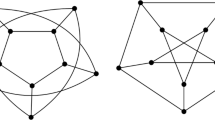Abstract
The notion of resistance distance as a convenient metric for graphs was introduced in Klein (J Math Chem 12:81–95, 1993). It is inspired by the concept of equivalent resistance for electrical circuits and has numerous applications, in particular, in organic chemistry, physics and random walks on graphs. Besides, computing resistance distance of various circuits has always been of interest for electrical engineers. In this paper, we provide a brief review of the concept and a physics perspective on resistance distance, highlighting some useful analytical methods for computing it. To some extend, these methods generalize and build on top of the results presented in Bapat (Math Stud 68(1–4):87–98, 1999, Indian J Pure Appl Math 41(1):1–13, 2010) and Kagan (Am J Phys 83:53–63, 2015). We then illustrate these methods using graphs with rotational symmetry as an example. The same analysis can be applied to computations of the complex impedance of AC-circuits of the same circular topology and can be used to investigate resonance phenomena therein. At the end, we discuss the concept of resistance distance in the context of the Weisfeiler–Leman stabilization.
Similar content being viewed by others
References
Klein, D.J., Randić, M.: Resistance distance. J. Math. Chem. 12, 81–95 (1993)
Bapat, R.: Resistance distance in graphs. Math. Stud. 68(1–4), 87–98 (1999)
Bapat, R., Gupta, S.: Resistance distance in wheels and fans. Indian J. Pure Appl. Math. 41(1), 1–13 (2010)
Kagan, M.: On equivalent resistance of electrical circuits. Am. J. Phys. 83, 53–63 (2015)
Klin, M.: Private communication at the conference ACA 2017, Jerusalem (2017)
Chair, N.: Exact two-point resistance, and the simple random walk on the complete graph minus \(N\) edges. Ann. Phys. 327(12), 3116–3129 (2012)
Chair, N.: The effective resistance of the N-cycle graph with four nearest neighbors. J. Stat. Phys. 154(4), 1177–1190 (2014)
Chair, N., Dannoun, E.M.A.: Two-point resistance of the Mobius ladder. Phys. Scr. 90(3), 035206–035211 (2015)
Kagan, M., Wang, X.: Infinite circuits are easy. How about long ones? arXiv:1507.08221
Essam, J.W. Tan, Z-Z., Wu F.Y.: Resistance between two nodes in general position on an m \(\times \) n fan network. Phys. Rev. E. 90(3), 032130 (2014). https://doi.org/10.1103/PhysRevE.90.032130
Gradshteyn, I., Ryzhik, I.: Tables of Integrals. Series and Products. Academic Press, Cambridge (1980)
Doyle, P., Snell, L.: Random Walks and Electric Networks. Mathematical Association of America, Washington (1984)
Author information
Authors and Affiliations
Corresponding author
Rights and permissions
About this article
Cite this article
Kagan, M., Mata, B. A Physics Perspective on the Resistance Distance for Graphs. Math.Comput.Sci. 13, 105–115 (2019). https://doi.org/10.1007/s11786-018-0340-x
Received:
Accepted:
Published:
Issue Date:
DOI: https://doi.org/10.1007/s11786-018-0340-x
Keywords
- Resistance distance
- Wheel graphs
- Star graphs
- Circulant graphs
- Equivalent resistance
- Random walks on graphs




